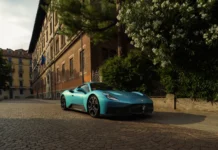Help #DriveOutHunger with Chicago Chesed Fund’s raffle, The Vortex! Win a choice of three luxury cars: 2019 Porsche 911 Carrera, Jaguar F Type R Dynamic, or Audi A8. Or pocket $50,000 cash instead.
Use promo code “FastLaneCar” to get 2 tickets for $175. But don’t delay, tickets are limited and this promo expires after 50 uses! A maximum of 4,999 tickets will be sold. The drawing will be held on Wednesday, April 10th, 2019. All proceeds benefit Chicago Chesed Fund, a 501(c)(3) non-profit organization, committed to helping families and individuals in need throughout the Midwest area. Enter to win and good luck! #DriveOutHunger

Has the engine gone bang in the past three years?
When you buy a hugely powerful car like the Dodge Challenger SRT Hellcat, you know you’re in for an equally huge dose of speed. That 707 horsepower has been well documented out there, as you’d expect. However, one thing that hasn’t been as widely shown is what the Challenger SRT Hellcat is actually like to live with. TFLcar has owned this long-term Hellcat for three years now, so we can actually comment on what the car has been like to live with in that time. Has it amassed a huge series of problems, or has it been a reliable shot of adrenaline with nary an engine blowup in sight?
Fortunately, the Challenger SRT Hellcat has been solid for these past three years. Apart from one unscheduled visit to sort a malfunctioning fuel rail pressure sensor, the only stops to the dealer have been for scheduled maintenance. As far as high-horsepower engines go, the Hellcat’s supercharged 6.2-liter V8 hasn’t been a major headache. What’s more, it’s managed to return an impressive 17.8 mpg according to the trip computer. That’s 20 percent better than the EPA estimates the Challenger Hellcat should achieve (16 mpg combined).

A few minor issues
That’s not to say TFL’s 2016 example has been entirely without faults. The panel fitment — particularly the hood — isn’t the best quality. The panel gaps aren’t consistent, with one end of the hood noticeably sticking up when it’s closed. On the interior, the huge driver’s bucket seat is wearing quickly on the outside bolster. Sticking with the seats for a moment, the front seats are fairly comfortable, while not particularly supportive. The back seats, as you’d expect in a large American coupe, are mainly ornamental. Apart from small children, few people would comfortably fit in the back. Happily, Dodge also slotted its Hellcat V8 into the altogether more practical Charger Hellcat as well.

What about the electronics?
Again, there’s not much to report on the car’s electronic faults either. Everything still works as it should, including FCA’s 8.4-inch Uconnect infotainment system. It’s an impressive system, offering a wide range of features, and it’s fairly responsive as well. The only exception to that is the SRT Performance Pages, which take an age to load. That’s not just in the Challenger Hellcat, either. We’ve had similar experiences in other SRT-powered models, like the Durango SRT and the Jeep Grand Cherokee Trackhawk.
Dodge does offer a shortcut button on the center stack to get to the SRT performance settings quickly. Apart from the full bore Track mode, we mainly run our long-term Hellcat in Eco mode. That does dial the power back to 500 instead of 707, but that’s plenty for just cruising around town.
Watch the video above for more on our long-term SRT Hellcat! Stay tuned to TFLcar.com for more news, views, reviews and long-term updates.























